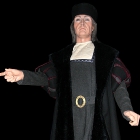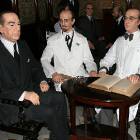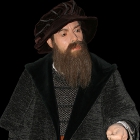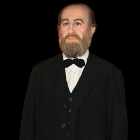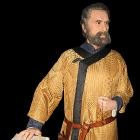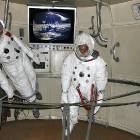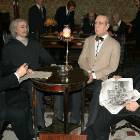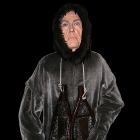Great explorers and visionary minds
Some explore every corner of the Earth in a boat, others simply use their imagination to describe space traveling in an age when speed meant horse pulled. While others use their minds to describe the technical means by which any device may function. Whether it’s curiosity or desire for fame, fortune and glory, there sure is something in man’s mind that determined even the most primitive tribes of the Pacific, to attempt crossing the ocean to the next island in a tree-carved canoe. It’s the spirit that made us conquer the space and reach inhospitable spots like the South Pole.
In a chamber in Barcelona’s Wax Museum, you can see such explorers and visionary men of science, next to other thematic rooms that include: movie inspired room of horrors and adventures, famous writers and famous statesmen.
Two hundred years before Columbus, Marco Polo took the moderate way to Asia, sailing East along the shoreline, as an alternative to the terrestrial route. It’s also important to note that he was leaving from Venice, on the East coast of Italian peninsula, not Spain like Columbus, thus not having to go round the entire African continent. Unlike Columbus, who would later be fascinated by the primitive tribes he found in Central American islands, Marco Polo expressed nothing but admiration for the Chinese civilization, which at the time was more advanced than West European.
Marco Polo came from a family of explorers and adventurers and was not even the first to reach such exotic lands, but what distinguished him was the way he captured the minds of Europeans with tales about exotic places. His book about his travel made quite a sensation in Europe, being copied, translated and transformed in at least 150 versions, like a folkloric tale. Just as interested in Marco Polo’s knowledge was Chinese emperor Kublai Khan, who practically held him prisoner for several years, but as a high esteemed counselor to his court.
Christopher Columbus was not the first European to set foot on American soil, but he proved decisive to colonizing the two newly discovered continents. Before him, navigators from the north, mainly Vikings, took a route closer to the Polar Circle, reaching the frozen shores of what is today Canada. Though Americans regard Columbus as the hero that linked their current country to the Old Continent, Columbus didn’t reach the borders of today’s United States either. Instead, in all his four historic voyages, Columbus only went from the islands close to Portugal and Spain to the exotic islands of Central America, some miles away from the thin stripe of land that connects South America to North America. Unlike the more modern ships, that brought immigrants from the British island to the shores of New York, exploring the vast land of USA was never Columbus’ thing.
The two American continents are not named something like North and South Columbia, because Columbus himself died with the belief that what he found was just an eastern extremity of Asia. The name of the continents of the New World comes from a later navigator, Amerigo Vespucci, who, two decades after Columbus, concluded that the two continents were distinct and quite far away from Asia.
What lead Columbus into this error of perception, but also helped him achieve such amazing tasks, was the fact that he was largely self-educated. With an impressive ambition, the Italian, born in Genoa, learned several languages, including Latin, that allowed him to study on his own old books on astronomy, geography or sailing, getting into contact with ancient knowledge or discoveries, like those made by the Arabs. The information he got convinced Columbus that a road to Asia was possible traveling West, with his day’s equipment, but made him estimate wrong the distance to Asia.
Contrary to popular belief, Columbus did not have to face the false belief that the Earth was flat, or that he would reach the end of the world. Learned men, including medieval clergies, knew that the Earth is not flat since Antiquity. And Columbus was quite a religious person, who even saw himself fulfilling prophecies from the Revelation about the End Times. Though his methods were many times ruthless, Columbus viewed himself as a missionary, whose main goal was to convert distant peoples to Christianity. The Catholic Church also proved decisive in helping him, not only by offering him shelter in a monastery when he was completely broke, but also in lobbying his expeditions to the Spanish crown.
Although religious, Columbus was a practical man, more interested in the lucrative outcome of his voyages, than in the scientific knowledge. He was a truly European citizen, moving from kingdom to kingdom in search of investors and sponsors of his projects. That’s why he is also known by his Italian name, Cristoforo Colombo, or by his Spanish name, Cristobal Colon. It was in Spain, in the Alcazar palace, where he finally convinced the royal family that his audacious plan was worth the investment. The reason why a new travel route to India and China was vital was that the Ottoman Turks had just seized Constantinople, blocking the land and sea route to the cheap riches of the Orient. These regions were major sources of spices, jewelries, tea, silk fabrics and even drugs. The Spanish crown had just completed Reconquista, the fight to regain the Iberian Peninsula from Muslim Moors, and saw this gamble of financing Columbus as a means to gain economic and political advantages, that would affirm Spain’s status as a world superpower.
Despite his deep religious feelings, Columbus was many times ruthless with the native population he discovered and ruled the islands in a dictatorial style, resorting to torture and actions that resulting in the death of some of his subjects. His behavior and his ambitions for acquiring wealth and political power made the Spanish monarchs forget their contractual promises made before the journeys, depose of his governor status and even have him arrested and locked with chains for a short period. Columbus is buried in the Cathedral of Seville, after his dead body was moved several times between continents.
Fernando Magellan was born a decade before Columbus “discovered America”. Stories about that, and about how Vasco da Gama sailed around Africa to reach India for the first time this way, probably excited him while entering adulthood, so he joined a cruise as soon as he had the opportunity. What made the Portuguese navigator famous was sailing around the globe for the first time in history, although he actually died trying, and only part of his fleet returned home.
In his voyages, Magellan gave name to the “peaceful” Pacific Ocean and was the first European to see a penguin, which he described as a featherless goose. Given the fact that he had to go round South America and Africa, the route Ferdinand Magellan took was much longer than the length of the Equator. The distance of the entire voyage was estimated at over 80.000 km, traveled in a little over a year. Fernando Magellan did not set out to circumvent the Earth and like Columbus he imagined India much closer and assuming he will return on the same path, around South America. The expedition was in fact a disaster: only 18 of 241 crew members survived, due to starvation, diseases caused by poor diet, killings during riots, defections and some were even abandoned for the sake of the precious spice cargo. Magellan himself died in the Philippines while engaging in a tribal dispute on the side of a local leader which he converted to Christianity. The mark he left on the population of those islands is still visible, as Philippines is even today a Catholic country.
Though people understood after Columbus, that the land found were new continents, and not Asia, Europeans continued to be convinced that Asia, and especially India and its near “spice islands”, are very near, not understanding that the Pacific Ocean is in fact the largest ocean of Earth. Juan Sebastian Elcano is the person who really achieved to circumnavigate the Earth, as the captain of the modest fleet, after the death of Magellan.
James Cook lived in the 18 century and is famous for exploring the islands of the Pacific, unknown to Europeans of his time. Cook, who came from a modest Scottish farmers family, explored New Zealand, Australia, Tahiti, Hawaii and others for the British Royal Navy.
Roald Amundsen was passionate about the extremes of the Earth, discovering the South Pole and leading the first expedition to reach the North Pole. In his South Pole expedition in 1911, Amundsen had a great competitor in Robert Scott, who took a different route and eventually died on the way. Part of Amundsen’s success was his choice for dogs instead of horses to pull the sledges, dogs which he didn’t shy away from killing and eating when necessary. For the North Pole expedition, the Norwegian and his crew also used a plane for some of the journey.
As soon as the Earth became charted and more or less conquered by man, space became the next challenge. Like the race between the naval powers for sea routes and colonies, space travel was also a competition between world’s superpowers of the moment: United States and Soviet Union. The latter managed to send the first artificial satellite of Earth, the first dog (Laika), to finally send humans in the outer space. Russian Yuri Gagarin was the first man in space, experiencing imponderability in 1961. His journey was short, he only took a brief circle trip around the globe, to land safely into the sea immediately. After becoming a world celebrity and an asset for Soviet propaganda, Gagarin died in a mysterious plane accident. After him, Valentina Tereshkova became the first woman in the outer space.
Such achievements and publicity stunts by the communist propaganda could not remain without a response in the capitalist world, so president Kennedy vowed to landing a man on the Moon. And indeed, Neil Armstrong reached the natural satellite of Earth with his historic words: “One small step for man, a giant leap for mankind!”. The second man to step out of the lunar module, Buzz Aldrin, knew he will lose the world fame of his colleague Armstrong, but recovered in time by also taking part in later expeditions.
Before taking off for other continents and planets, man needs not only technology, ambitions, beliefs and skills, but also audacious ideas, that come from visionary individuals. Such a person was Jules Verne, who in the XIX century, wrote captivating stories about voyages with means that were yet to be discovered. The writer was passionate about traveling, but used his mind to imagine new means of transport, such as the submarine, a rocket that would go “from Earth to the Moon”, an airplane, or to imagine a balloon that would allow a voyage around the Earth. He also envisioned a world in which people would live in glass skyscrapers and drive high speed cars, in a time when horse pulled carts were the usual means of transport. Other prophetic writings by Jules Verne include technologies like: rockets powerful enough to reach the moon, radio news, writing in the sky for advertising purpose, solar panels for space traveling, video-conference systems, electroshock guns, electric trains, something similar to an atom bomb, undersea mining. Jules Verne was friend with other important French writers like Alexandre Dumas and Victor Hugo.
The technology, dreamed by visionary minds and used by courageous explorers, needs to comply with the laws of physics, therefore requires a lot of calculations and groundbreaking theories. Mathematicians, physicists and engineers rarely become celebrities or even known to general public. But Albert Einstein managed to become a superstar of science and now his name is associated with that of a scientific genius. Einstein was awarded the Nobel price for his contribution to photoelectric studies and is famous for his general theory of relativity, which influenced not only physics, but also how people view the universe. Some question the originality of his work, doubting that a modest clerk at the patent office would have had more access to the ideas of others than academic scale, while others accuse him for convincing FDR to invest American resources in developing the atomic bomb.
Mai multe despre: Spain • Albert Einstein • Barcelona • Barcelona Wax Museum • Christopher Columbus • Fernando Magellan • James Cook • Jules Verne • Marco Polo • Neil Armstrong • Roald Amundsen- Home Page
start page - Architecture
landmark buildings - Sacred architecture
places of worship - Nature
landscape photography - Concert
performing artists - Christmas
Santa Claus pictures
- Jooble
jobs for photographers - Escape
an out of control blog - Merry Christmas
The best organizer of Christmas parties - Astro photo
Eclipse hunting and astrological photography


